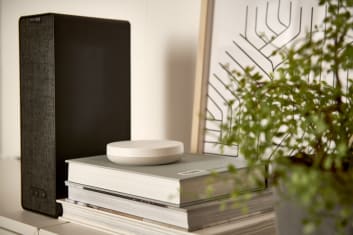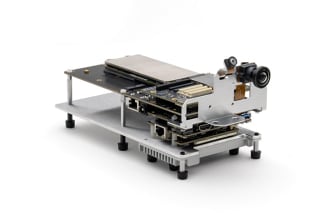The State of IoT – May 2022
Edoardo Barbieri
on 6 June 2022
Tags: Embedded , IoT , stateofiot
Welcome to the May edition of the monthly State of IoT series.
May was a month full of exciting news, from open-source GPU modules and alternatives to the Jetson to a new Matter-ready hub for smart home appliances.
Before diving straight in, let’s cover noteworthy news not included in the recap below.
A few tech companies announced interesting partnerships this month.
- Google partnered with ASUS to spread the availability of Coral, its platform for AI computing at the edge.
- STMicroelectronics unveiled collaboration efforts with Microsoft for a reference integration of STM32U5 microcontrollers with Azure RTOS.
- Telstra, Google, and Accenture developed a 5G powered augmented reality experience at Melbourne’s stadium.
- MediaTek announced a new platform for AIoT workloads, the Genio 1200, commercially available from H2 2022.
- In the public sector, the British Government made $50 million available to promote the development of self-driving buses in the U.K.
Without further ado, let’s now go deeper into the most prominent news across the IoT landscape from last month.
NVIDIA open-sources GPU kernel modules
Back in the day, Linux developers wishing to steer clear of NVIDIA’s proprietary stack reverse-engineered its GPU features into what was named the Nouveau project. Much has changed since Linus snubbed NVIDIA in 2012 for hiding from the FOSS world.
A couple of years later, the chipmaker provided significant technical guidance and was involved in architectural changes to Nouveau to support the GK20A GPU for Tegra K1 chips. Those contributions even earned them a “thumbs up” by Linus himself.
Despite NVIDIA’s best efforts to offer Linux driver support with their proprietary stack, Intel and AMD’s decade-long open-source driver effort called for more contributions from the graphic card maker. In August 2020, NVIDIA unveiled its open-source GPU documentation GitHub page, generating suspicions of it conceding its purely proprietary culture.
This month, NVIDIA finally open-sourced kernel modules for their GPUs. With what was by now a much-awaited transition towards the landscape of open-source software, the silicon vendor released the kernel driver under a dual MIT/GPL license. Cindy Goldberg, VP of Silicon alliances at Canonical, noted how the new NVIDIA open-source GPU kernel modules simplify installs and increase security for Ubuntu consumers, whether AI/ML developers, gamers or cloud users.
It’s worth mentioning that NVIDIA didn’t upstream the out-of-tree, open-source kernel drivers. Furthermore, because there can only be one driver for the same hardware in the Linux kernel, upstreaming will require lots of work in the Mesa graphics library and Nouveau. Also, one can’t avoid noting that most modern graphics drivers still reside in the closed-source firmware and userspace components. Hector Martin from Asahi Linux criticised NVIDIA for moving most of the kernel driver into the firmware, called into by the open-sourced components.
AMD releases new robotics starter kit
Last May, AMD unveiled the Kria™ KR260 Robotics Starter Kit for robotics and industrial applications.
Compared to chip-down design, the Kria adaptive system-on-module (SOM) approach accelerates the design cycle and shortens the time to deployment by up to nine-month. AMD is targeting rapid robotics deployment at a compelling price with its latest release.
As a new addition to the Kria portfolio, the KR260 Kit is a complete development platform for robotics applications, machine vision, industrial communication and control. The Kria KR260 Starter Kit (Kria SOM + Carrier Card + Thermal Solution) offers native support for ROS 2, the de-facto open-source framework for building robot solutions.

with Kria KR260 Robotics Starter Kit
The Ubuntu 22.04 LTS operating system is the best choice to get up and running with the KR260. Robotics and industrial developers can now get started in minutes by following these steps.
IKEA launches a Matter-ready hub
Matter is a royalty-free IPv6-based connectivity standard which defines the application layer deployed on devices. The Matter specification supports Wi-Fi, Thread and Bluetooth Low Energy (BLE). Although proprietary, i.e. licensed by the Connectivity Standards Alliance (CSA), formerly Zigbee Alliance, the code is open-source.
Last March, the CSA announced a delay in releasing the specification of Matter. Citing additional tests, Matter’s SDK will be feature-complete this spring, with Version 0.9 of the specification available to all Alliance members towards mid-year. We were expecting that the delay would push back the shipment of Matter-certified products. In May, however, IKEA announced a Matter-ready hub for smart products.
Coupled with the IKEA Home smart app, the DIRIGERA hub aims to streamline the onboarding process when connecting appliances to the smart home. The Matter-ready hub and the app will be available in October, sustaining the continued growth in the smart home industry.
Nokia unveils SaaS services for home device management
IKEA wasn’t the only player making moves in the smart home sector last May. Approaching the vertical from a different angle in the tech stack, Nokia announced two new Software-as-Service (SaaS) offerings.
Nokia Home Device Management is a Customer Premise Equipment (CPE)-vendor-agnostic system providing management capabilities ranging from zero-touch provisioning and configuration updates to software upgrades, monitoring, and troubleshooting. Nokia touts their Device Manager solution supports any vendor and device, simplifying CPE management in home networks.
The second service revealed by Nokia targets network energy efficiency. Nokia AVA (Analytics Virtualization and Automation) for Energy SaaS aims to minimise the carbon footprint and network energy costs of telco networks. The new energy management automation platform uses AI to benchmark the energy efficiency of passive infrastructure, like batteries and power supplies.
Nokia AVA for Energy SaaS’ approach is in stark contrast with conventional energy-saving methods, relying on pre-defined static shutdown windows, unfit for complex savings scenarios. Nokia argues the new service aligns with its commitment to 50% emissions reduction between 2019 and 2030 across its value chain.
Qualcomm announces new robotics solutions
AMD’s wasn’t the only announcement in the robotics arena from last May.
Qualcomm revealed its RB6 Platform and RB5 AMR Reference Design, aiming to bring AI and 5G capabilities to the next generation of autonomous mobile robots.
The Robotics RB6 Platform is an all-in-one hardware solution for autonomous robotics. Qualcomm’s new solution is Wi-Fi 6-ready and includes 5G connectivity with support for global sub-6GHz and mmWave bands. The RB6 Platform targets streamlined robotics development via its suite of AI SDKs, including multimedia, AI/ML and computer vision capabilities.
Branded as the first AMR reference design with integrated AI and 5G, the RB5 AMR builds on the company’s extensive AI and 5G portfolio. Qualcomm already has a readily-available 5G and AI-integrated solution for drones, the Flight RB5 5G Platform. Moving past autonomous flight, Qualcomm is now targeting indoor navigation capabilities for autonomous robots via its RB5 AMR Reference Design. The robotics RB5 AMR is allegedly capable of navigating in GPS-denied environments by relying on Simultaneous Localization and Mapping (SLAM), a class of algorithms targeting indoor navigation. The Reference Design is “coming soon” and those interested can sign up for an email notification to be the first to know once available.
Stay tuned for more IoT news
We will soon be back with next month’s summary of IoT news. Meanwhile, join the conversation on IoT Discourse to discuss everything related to the Internet of Things and tightly connected, embedded devices.
Further reading
Why is Linux the OS of choice for IoT devices? Find out with the official guide to Linux for embedded applications.
Do you want to work on your next IoT project, but are unsure which OS to pick? Learn about the trade-offs between Yocto and Ubuntu Core now.
In case you are ready to get started on the de-facto development platform for IoT, learn about embedded Linux development on Ubuntu.
If you need to go back to the basics, learn what is embedded Linux today.
Open source is what we do
We believe in the power of open source software. Besides driving projects like Ubuntu, we contribute staff, code and funding to many more.
Newsletter signup
Related posts
Real-time OS examples: use cases across industries
In sectors where precision and predictability are non-negotiable, timing is everything. Whether coordinating robotic arms on a factory floor, maintaining...
How to enable Real-time Ubuntu on your machine
If you’re here, you likely already know about preemption, determinism, and real-time capable operating systems. If that’s the case, and you want to learn how...
The State of Silicon and Devices – Q2 2025 roundup
Welcome to the Q2 2025 edition of the State of Silicon and Devices by Canonical. In this quarter, we have seen momentum accelerate in edge computing, as well...





